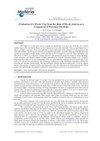Calibration of Concrete Damaged Plasticity Model parameters for shear walls
IF 1.2
4区 材料科学
Q4 MATERIALS SCIENCE, MULTIDISCIPLINARY
引用次数: 7
Abstract
Reinforced concrete structures are relatively complex to analyze, with nonlinear effects like cracking, crushing, steel yielding, aggregate interlock, dowel effect, concrete-rebar interaction and so on. The concrete damaged plasticity CDP model is a consolidated smeared-crack model which accounts for multiaxial behavior with good agreement to experimental results. One particular relevant application which benefits greatly from such feature is the shear wall, as shear stress significantly influences its overall behavior, therefore multiaxial constitutive models and three-dimensional finite elements usage consist in a fitting modeling approach. Reinforced concrete shear walls are structures especially useful for lateral force-resisting systems, as they provide ductility, stiffness and strength. Albeit CDP is widely applied, its parameters are not consensus in the literature, which represents a relevant research gap. The present work considers and compares CDP parameters from relevant literature, in order to calibrate those parameters for the case of reinforced concrete shear walls. To this purpose, four wall experiments related in the bibliography are modeled using solid finite elements for concrete and trusses for rebars using commercial package ABAQUS. All walls are flexure-controlled with aspect ratio greater than 2.0. By varying those parameters and comparing obtained force vs. displacement curves and interesting values attained, like yield lateral force and displacement, stiffness and maximum lateral force, it is settled a set of parameters with acceptable response focusing in the post-peak response based on the lower estimated error of displacement capacity. Those parameters agree reasonably with literature, although it is possible that obtained calibration is restricted to flexure controlled shear walls scope. It is possible that usage of trusses to represent reinforcement does not consider dowel effect, so a suggestion for future studies is to change trusses for elements with transverse stiffness, like beams or solids. Keywords: calibration, concrete damaged plasticity, concrete constitutive model, shear walls.剪力墙混凝土损伤塑性模型参数的标定
钢筋混凝土结构的分析相对复杂,具有开裂、破碎、钢筋屈服、骨料互锁、销钉效应、混凝土-钢筋相互作用等非线性效应。混凝土损伤塑性CDP模型是一种固结的涂抹裂纹模型,其多轴特性与试验结果吻合较好。一个特别相关的应用,极大地受益于这种特征是剪力墙,因为剪切应力显著影响其整体行为,因此多轴本构模型和三维有限元的使用包括拟合建模方法。钢筋混凝土剪力墙是一种特别适用于抗侧力系统的结构,因为它们具有延展性、刚度和强度。虽然CDP被广泛应用,但其参数在文献中并未达成共识,这代表了相关研究的空白。本工作考虑并比较了相关文献中的CDP参数,以便对钢筋混凝土剪力墙的参数进行校准。为此,参考书目中相关的四个墙体实验使用混凝土实体有限元和钢筋桁架使用商业软件包ABAQUS进行建模。所有墙体均为柔性控制,纵横比大于2.0。通过改变这些参数,比较得到的力与位移曲线和得到的感兴趣的值,如屈服侧向力与位移、刚度和最大侧向力,根据较小的位移容量估计误差,确定一组响应可接受的参数,集中在峰后响应中。这些参数与文献基本一致,但可能得到的校准仅限于受弯控制的剪力墙范围。使用桁架来表示加固可能没有考虑到销钉效应,因此未来研究的建议是将桁架改为具有横向刚度的单元,如梁或实体。关键词:标定,混凝土损伤塑性,混凝土本构模型,剪力墙。
本文章由计算机程序翻译,如有差异,请以英文原文为准。
求助全文
约1分钟内获得全文
求助全文
来源期刊

Materia-rio De Janeiro
MATERIALS SCIENCE, MULTIDISCIPLINARY-
CiteScore
1.00
自引率
25.00%
发文量
51
审稿时长
6 weeks
期刊介绍:
All the articles are submitted to a careful peer-reviewing evaluation process by the journal''s Editorial Board. The Editorial Board, reviewers and authors make use of a web based proprietary automated tool to deal with the reviewing procedures.the Revista Matéria''s article reviewing restricted access system - SEER. Authors are not informed about the identity of the reviewers.
 求助内容:
求助内容: 应助结果提醒方式:
应助结果提醒方式:


